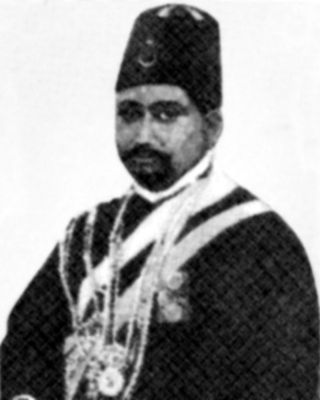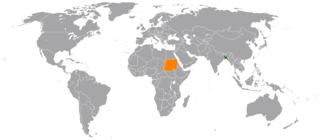
Syed Ismail Hossain Siraji was a Bengali author and poet from Sirajganj in present-day Bangladesh. He is considered to be one of the key authors of period of the Bengali Muslim reawakening; encouraging education and glorifying the Islamic heritage. He also contributed greatly to introducing the Khilafat Movement in Bengal, and provided medical supplies to the Ottoman Empire during the Balkan Wars. Anal-Prabaha, his first poetry book, was banned by the government and he was subsequently imprisoned as the first South Asian poet to allegedly call for independence against the British Raj. The government issued Section 144 against him 82 times in his lifetime.
Mohammad Yakub Ali Chowdhury was a Bengali essayist and journalist. He was noted as one of the few Bengali Muslim literary scholars of his time.

Dhaka (Dacca) is a modern megacity with origins dating to circa the 7th century CE. The history of Dhaka begins with the existence of urbanised settlements that were ruled by the Hindu Gauda Kingdom, Buddhist and Shaivite Pala Empire before passing to the control of the Hindu Sena dynasty in the 10th century CE. After the Sena dynasty, the city was ruled by the Hindu Deva Dynasty.

Hakim Habibur Rahman was an Unani physician, litterateur, journalist, politician and chronicler in early 20th-century Dhaka.

Nāsir ad-Dīn Naṣrat Shāh, also known as Nusrat Shah, was the second Sultan of Bengal belonging to the Hussain Shahi dynasty. He continued with his father's expansionist policies but by 1526, had to contend with the Mughal ascendency in the Battle of Ghaghra. Simultaneously, Nasrat Shah's reign also suffered a reverse at the hands of the Ahom kingdom. The reigns of Alauddin Husain Shah and Nasrat Shah are generally regarded as the "golden age" of the Bengal Sultanate.
Jatrabari Thana is a metropolitan thana within the megacity of Dhaka in central Bangladesh. It is known for its steel furniture industry.
Shāhzāda Bārbak, known by his regnal title as Ghiyāsuddīn Bārbak Shāh, was the Sultan of Bengal in 1487 and the founder of the Sultanate's Habshi dynasty. He was a former commander of the palace-guards of Jalaluddin Fateh Shah court.

Mohammad Mozammel Huq was a Bengali-language poet, novelist, magistrate and educationist. His writings were said to have been inspired by a "Muslim renaissance".
Nawab Bahadur was a title of honour bestowed during Mughal Empire and later during British Raj to Indian Muslim individuals for faithful service or acts of public welfare.

Sari or Shari gan is a traditional form of folk music in Bangladesh are usually sung by boatmen and other workers groups. It is common for Sari gan to be sung during Nouka Baich competitions.

Bilateral relations exist between Bangladesh and Austria. Relations between the two countries have been considered cordial with both the countries working towards further strengthen it. Bangladesh has an embassy in Vienna which also serves as the Permanent Mission of Bangladesh to the United Nations and other international organizations.

Bangladesh–Sudan relations refers to the bilateral relations between Bangladesh and Sudan. Colleges in Bangladesh, like the Sher-e-Bangla Medical College, have hosted students from Sudan.
Mirza Muhammad Yusuf Ali was a Bengali writer and reformer in British India.

Shāh ʿAlī al-Baghdādī was a 15th-century Muslim missionary and Sufi saint based in the Faridpur and Dhaka regions of Bengal.

Sikhism in Bangladesh has an extensive heritage and history, although Sikhs had always been a minority community in Bengal. Their founder, Guru Nanak visited a number of places in Bengal in the early sixteenth century where he introduced Sikhism to locals and founded numerous establishments. In its early history, the Sikh gurus despatched their followers to propagate Sikh teachings in Bengal and issued hukamnamas to that region. Guru Tegh Bahadur lived in Bengal for two years, and his successor Guru Gobind Singh also visited the region. Sikhism in Bengal continued to exist during the colonial period as Sikhs found employment in the region, but it declined after the partition in 1947. Among the eighteen historical gurdwaras in Bangladesh, only five are extant. The Gurdwara Nanak Shahi of Dhaka is the principal and largest gurdwara in the country. The Sikh population in the country almost entirely consists of businessmen and government officials from the neighbouring Republic of India.
Ashrafuddin Ahmad Chowdhury was a Bengali politician who had served as general secretary of the Congress Party's Bengal branch, member of the East Bengal Legislative Assembly and later as the education minister of Pakistan. He was an advocate of Huseyn Shaheed Suhrawardy's United Bengal proposal.
Martyr Lt. Anwar Hossain was a Bangladesh Army officer who fought in the Bangladesh Liberation War. He was killed in the war and posthumously awarded Bir Uttom, the second highest gallantry award in Bangladesh.
The Kohinoor was a Bengali language newspaper, first published in July 1898. Initially focusing on miscellaneous topics such as Islamic culture, its third relaunch was a pivot of Hindu-Muslim harmony. The paper targeted both Hindu and Muslim clientele.

Tanda, also known as Tandah and Khwaspur Tandah, was a historic 16th-century city of Bengal in the eastern part of South Asia, and one of the most prominent medieval capitals; serving the Karrani Sultans of Bengal and the early Mughal governors of Bengal.


















